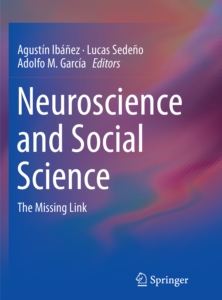Moral cognition and moral emotions
Nueva York: Springer
Baez, S., García, A. M., Santamaría-García, H. (2017). Moral cognition and moral emotions. En A. Ibáñez, L. Sedeño & A. M. García (eds.). Neuroscience and Social Science: The Missing Link (pp. 170-197). Nueva York: Springer. Online: http://bit.ly/2hi8dlP.
Este capítulo reseña los principales hallazgos de las neurociencias cognitivas en torno a la cognición moral, un dominio complejo que implica interacciones entre el razonamiento y la emoción para ponderar el bien y el mal. Consideramos evidencia de diversos abordajes experimentales y discutimos sus implicancias para contextos sociales cotidianos.
Para acceder al capítulo completo, hacé click aquí.
Moral cognition and moral emotions
Nueva York: Springer
Baez, S., García, A. M., Santamaría-García, H. (2017). Moral cognition and moral emotions. En A. Ibáñez, L. Sedeño & A. M. García (eds.). Neuroscience and Social Science: The Missing Link (pp. 170-197). Nueva York: Springer. Online: http://bit.ly/2hi8dlP.
Moral cognition, a central aspect of human social functioning, involves complex interactions between emotion and reasoning to tell right from wrong. In this chapter, we summarize the cognitive neuroscience literature on moral cognition and moral emotions, highlighting their close relationship with other social cognition domains. We consider neuroimaging research and behavioral/neuropsychological evidence of moral impairments in patients with psychiatric and neurological conditions. We also describe cognitive neuroscience models claiming that moral cognition processes are shaped by the encompassing social context. These views emphasize how cultural and context-dependent knowledge, as well as motivational states, can be integrated to explain complex aspects of human moral cognition. Finally, we address real-life social scenarios on which available studies could make a direct impact. More generally, we analyze the extent to which moral cognition research can help to understand human social behavior and complex social-moral circumstances.
To access the full chapter, please click here.



